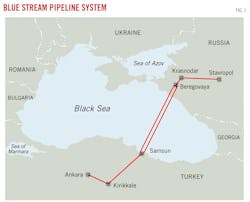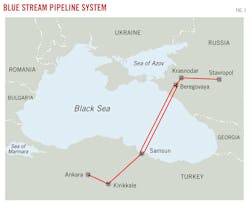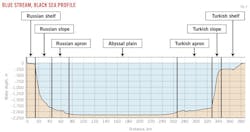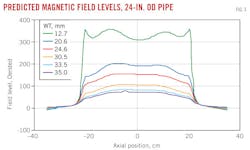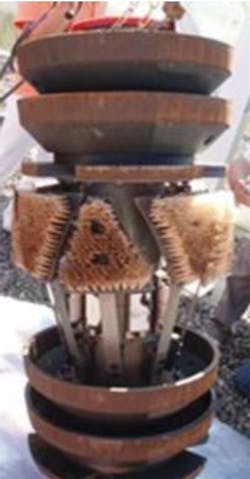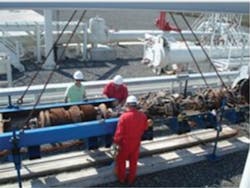Ron James
PII Pipeline Solutions
Cramlington, UK
| Based on presentation to the Pigging Products and Services Association Seminar, Aberdeen, Nov. 16, 2011. |
In-line inspection of the Blue Stream natural gas pipelines' subsea segments required development of technology and methods first to prevent tools from getting stuck at water depths of up to 2,150 m and then to rescue them should this occur. This article details the planning of this inspection.
Infrastructure
The Blue Stream Pipelines supply gas from the network of southern Russia to Turkey (Fig. 1). Blue Stream, which carries 16 million cu m/year (1.55 MMcfd), is 1,250 km (775) long: 373 km of 56-in. OD pipe from Stavropol to Dzhubga, Russia, owned by Gazprom; twin 380 km, 24-in. OD pipelines across the Black Sea from Dzhubga to the Durusu station at Samsun, Turkey (a Gazprom-ENI joint venture, the Blue Stream Pipeline Co., BSPC), and a 470 km, 48-in. OD pipeline, operated by Botas, to pipeline networks at Ankara.
The two offshore pipelines were laid at 2,150 m (Fig. 2), making inspection and maintenance difficult.
Project requirements
The BSPC inspection project consisted of:
• Pipeline cleaning and proving, to ensure the pipeline was clean enough to receive subsequent inspection vehicles.
• Running a caliper tool to detect dents or ovalities in the as-laid pipelines.
• Completing an out-of-straightness survey to detect and measure the out-of-straightness or strain events in the as-laid conditions and free spans.
• Completing a magnetic flux leakage (MFL) high resolution metal-loss survey to inspect for any metal loss or corrosion.
BSPC, made of 32-mm (1.25-in.) WT pipe with an internal epoxy coating, includes reduced-bore tees (83% of OD), 7D bends, ball valves, barred tees, and buckle arrestors. It operates at 250 bar (3,625 psia) at temperatures between –10° C. and 55° C. with a flow rate of 2.5 m/sec.
Approach
A feasibility study reviewed the pipeline and operational specific features and identified technical risks. The main identified problems were:
• The 32-mm WT.
• The reduced-bore tees, to cater for thick wall transitions at the tee near the receiver trap.
• The 250-bar pressure.
Avoiding any form of lodging in the pipeline or damage to its internal coating stood as the primary concerns. All tools also had to survive the 380-km journey.
Engineering layouts and early magnetic analysis on the 24-30 in. MFL inspection tool verified its compatibility with the bore passing and WT. Identifying technical and operational risks led to a proposal outlining what adjustments needed to be made to the tool and what tests had to be completed early in the main program to improve its probability of success.
The subsequent development phase concentrated on:
• Engineering design and proof of concept.
• Sizing model generation.
• Tool design and build.
• Project execution.
CAD simulation
Saturating the pipe wall with enough magnetic flux to conduct a successful inspection was one of the biggest problems in tool design. 3D CAD simulation modeled bore-passing and feature-passing requirements of the BSPC pipeline and at the same time checked for magnetic saturation in the thick-wall sections.
The most severe geometry feature in the pipeline was the 505-mm diameter (17% restriction) thick-wall tee near the receiving site and the 32-mm WT sections. Buckle-arrestor sections (47-mm WT) were integrated as part of the pipeline at installation.
Enhanced flux handling techniques generated an articulated bar return-path design superior in handling the magnetic field as compared with conventional sweep brush techniques. Proven concepts previously used to increase WT capabilities on small-diameter tools but not previously used on a segmented body tool provided the basis for this approach. Tool design included the most powerful commercially available rare earth magnets in the maximum volume to achieve local full-bore passing requirements of the thick-wall tee.
The magnetic vehicle's articulated return path allowed for application in 24 to 30-in. OD pipe. BSPC only required the 24-in. mode, allowing lockdown of the articulated mechanism at that diameter and enhancing reliability.
Fig. 3 shows predicted magnetic field levels for magnetizer arrangements on different WT in the axial orientation. The predicted levels check stability or flatness of the field levels relative to axial position. These checks then determine optimum position for the sensors. Fig. 3 shows field levels to be relatively flat for the BSPC WT range, allowing some flexibility in positioning the sensors axially.
Results demonstrated the magnetic circuit as capable of inspecting 32 mm WT at 2 m/sec (6.56 fps) minimum.
Data analysis
The high pressures exerted on the external surface of the pipeline, by both the water depth and the gas inside the pipeline, required careful consideration to ensure actual forces were being calculated at any given depth. BSPC's subsea data analysis software accounted for external collapse pressures as well as internal process forces dynamically and progressively for the entire Black Sea length of the pipe.
Pig recovery
Ensuring that no tool would get stuck in the pipeline and block production guided tool design and development. Most large, complex, intelligent inspection systems are multi-module to accommodate the magnetic module, front-end processing data storage, and power supply functions. Pushing the tool from behind would tend to jackknife the couplings, damaging the tool to the extent that the rear-most modules behind the magnetic vehicle become disconnected from the main inspection train.
PII had previously designed a 24-30-in. multidiameter thick-wall inspection system for operation in liquid pipelines at depths of 7,700 ft, capable of negotiating vertical asymmetric equal and unequal wyes. Bringing this experience to the BSPC project ensured that design of semirigid tow bars could accommodate the various loading conditions imposed during normal pigging operations and at the same time remain structurally sound enough to be pushed from the rear.
Engineering simulations determined the best combination of semi-rigid tow coupling. Prototyping and testing the designs ensured satisfactory performance for:
• Tensile loading. The ability to pull the trailing modules through the pipeline.
• Compression loading. The ability to withstand the compressive loads generated when the high-drag lead module suddenly slows at a thick-wall transition or bend and the inertia of the trailing modules tries to push it closer.
• Offset strut loading. The ability to withstand the offset loads caused during negotiation of thick-wall transitions or bends—as per compression loading—but with the axes of the adjacent modules offset.
• Bending loading. The ability to withstand bending load induced on the tow bar while negotiating bends.
• Torsion loading. Trailing modules of MFL pigs are designed to induce rotation of the tool to ensure even wear and improve drive and sensor reliability. The tow bar assembly must withstand the torsional loading to minimize the torsional misalignment between the main corrosion sensors and the positional recording system in the data acquisition pack.
PII designed several prototype semi-rigid tow-coupling units, built the hardware, and conducted prototype tests to hone final design. A flat push plate at the rear of the train allowed a recovery pig to push the train. PII demonstrated that a recovery pig could be maneuvered behind the stationary inspection tool and push the whole arrangement through the test rig, including one containing an asymmetric wye.
Location, tracking
An electromagnetic transmitter fitted to the tool and magnetic sensitive timer boxes placed at strategic positions along the onshore pipeline sections allowed finding the pig in the event it became stuck. A suitable receiving device fitted to a remotely operated vehicle could find the pig in the pipeline's subsea portion. The client insisted, however, that the pig be recovered by another pig, prompting the emphasis on recovery strategy. Acoustic monitors fitted at launch and receive sites allowed tracking and monitoring the pig's position.
Pipeline pressure
Standard PII MFL inspection systems can operate in both liquid and gas to 220 bar. Testing certified the 24-30 in. system used on the BSPC pipeline for 400 bar operation in liquid pipelines and 250 bar in gas pipelines.
Cleaning tool design had to balance the desire to get the pipeline as clean as possible with the need to avoid damaging the internal coating. Removal of dust or debris in the pipeline is crucial to a successful inspection, however, too much abrasion can damage the internal coating. Fig. 4 shows the received cleaner, with minimal wear considering pipeline length. The quantity of dust and debris captured was very small due to the quality of the gas and transportation process and the construction of the pipeline.
Project summary
BSPC received inspection results following successful runs on both pipelines. Fig. 5 shows the MFL tool following the 380-km run. Inspection included tracking the pigs on both of the onshore sections both acoustically and magnetically. Launching the tools in Russia and receiving them in Turkey presented the team with customs and local certification issues, including requirements from both countries to produce local operating licenses and permits to import and operate the tools, and for documentation to be in both languages.
All pigs launched into the BSPC pipelines were safely received on time, and the rescue pig mobilized with the rest of the equipment was not required during operations. Calculated run times measured 92 hr and actual run times were within 15 min of the calculations. Saipem provided the technical consultants responsible for computing run times.
Acknowledgments
Thanks to Massimo Volpini, technical manager, BSPC; Francesco Tommasi, procurement manager, BSPC; and Claudio Mondo, project manager, Saipem Energy Services.
The author
More Oil & Gas Journal Current Issue Articles
More Oil & Gas Journal Archives Issue Articles
View Oil and Gas Articles on PennEnergy.com
